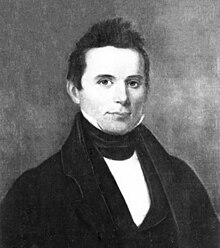Elias Boudinot (Cherokee)
| Elias Boudinot | |
|---|---|

Elias Boudinot
|
|
| Born |
Gallegina Uwati (ᎦᎴᎩᎾ ᎤᏩᏘ) 1802 Oothcaloga, Cherokee Nation (now Calhoun, Georgia) |
| Died | June 22, 1839 (aged 36–37) Park Hill, Cherokee Nation West (now Oklahoma) |
| Resting place | Worcester Mission Cemetery, Park Hill |
| Other names | Buck Watie |
| Spouse(s) | Harriet R. Gold(1823 - 1836), Delight Sargent (ca 1837 - 1839) |
| Signature | |
Elias Boudinot (born Gallegina Uwati [ᎦᎴᎩᎾ ᎤᏩᏘ], also known as Buck Watie) (1802 – June 22, 1839), was a member of a prominent family of the Cherokee Nation who was born in and grew up in present-day Georgia. His Cherokee name reportedly means either 'male deer' or 'turkey.' Educated at a missionary school in Connecticut, he became one of several leaders who believed that acculturation was critical to Cherokee survival; he was influential in the period of removal to Indian Territory. In 1828 Boudinot became the editor of the Cherokee Phoenix, the first Native American newspaper. It published in Cherokee and English, to showcase Cherokee achievements as well as to build unity within the Nation while under United States pressure for Indian Removal.
In 1826, Boudinot had married Harriet R. Gold, the daughter of a prominent New England family in Cornwall, Connecticut. He met her while a student at the Foreign Mission School in town. Following his cousin John Ridge's marriage to a local woman there in 1825, Boudinot's marriage was controversial and opposed by many townspeople. The Cherokee National Council had passed a law in 1825 enabling the descendants of Cherokee fathers and white mothers to be full citizens of the Cherokee. (Formerly they had no official place in the matrilineal tribe, as children belong to their mother's clan and people.) The Boudinots returned to Georgia to live at New Echota. They reared their six children as Cherokee.
Boudinot believed that removal was inevitable. He and other treaty supporters signed the Treaty of New Echota in 1835, but it was not signed by John Ross, the Principal Chief, and was opposed by most of the tribe. The following year the tribe was forced to cede most of its lands in the Southeast, and remove to the West.
After Harriet died in 1836, Boudinot moved with his children to Indian Territory. He and three other Treaty Party leaders were assassinated in June 1839 by members of the Ross faction known as the National Party. The orphaned children were sent to his parents-in-law in Connecticut and went to school there. His son Elias Cornelius Boudinot was educated there and then returned west, settling in Fayetteville, Arkansas. He became an attorney and active in tribal and Democratic Party politics.
...
Wikipedia
